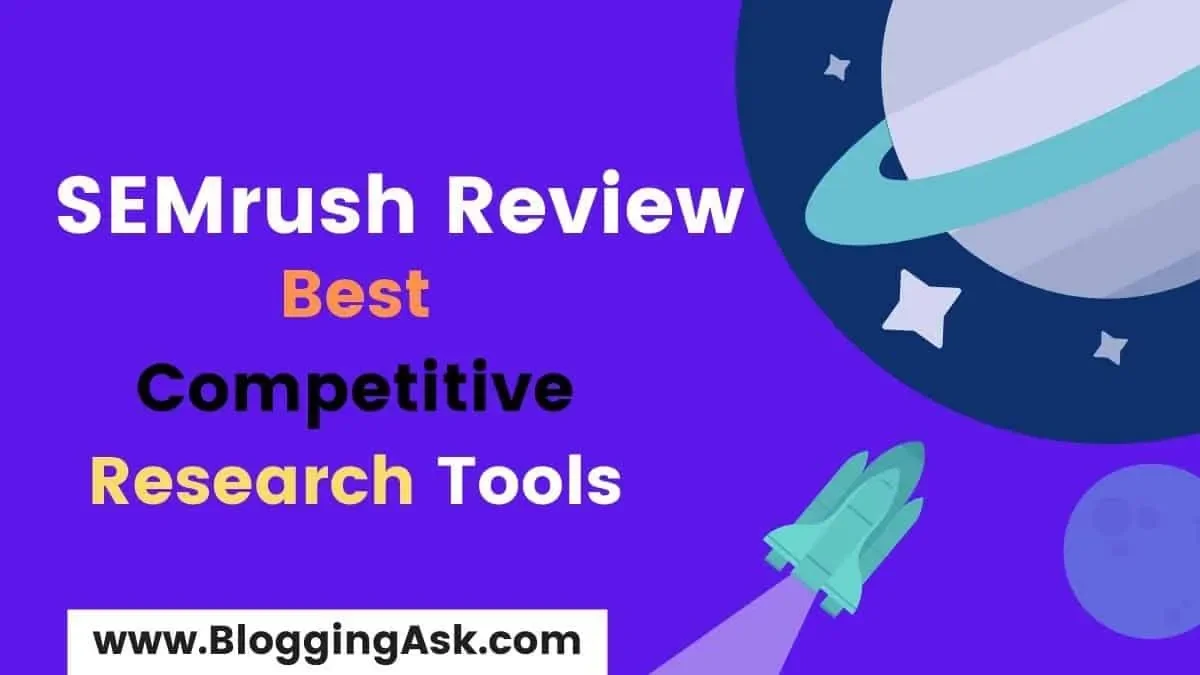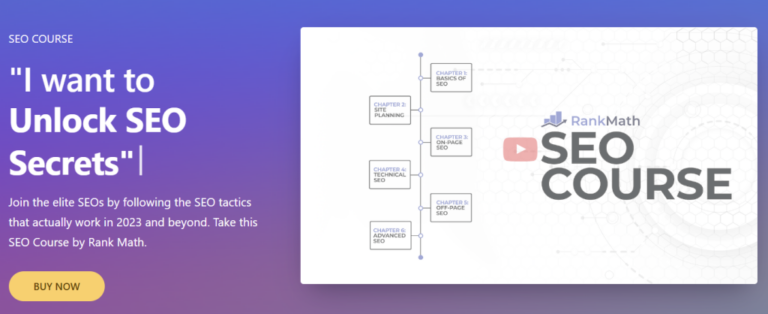Do you want to outrank your competitor?
Do you want to drive huge organic traffic to your blog?
Do you want to earn more money?
Or
Do you want to rank on the first page of the search engine like Google, Bing, Yahoo, Yandex, etc?
If your answer is yes to all the above questions, then don’t worry. Sit back on your couch and relax, I will help you out. Because I am going to show you the SEMrush review.
Today, I am going to put on test an advanced competition research tool recognized as SEMrush.
This is the secret behind my site’s ranking on the first page of Google. (I am not talking about this site, I have many other sites as well.)
Let’s Get Started.
So let’s start this topic but first let me tell you what exactly the SEMrush is?
What is SEMrush?
SEMrush is an advanced tool that is designed to do complete SEO on your blog.
This is the only smart tool and secret behind every successful blogger by doing the following easy steps.
- In-depth Keyword Research
- Keyword Tracking and its ups and downs.
- Complete SEO Audit of your Blog or your client’s blog.
- In-depth competitor Research
- Backlink Strategy and Opportunity for Your Blog
SEMrush is an Advanced Digital Marketing tool that helps everyone in the industry to beat its competitor and grow their marketing.
You must have heard the phrase “Don’t work hard, Work Smart”.
SEMrush helps you in working smartly not hardly that’s why there are no alternatives to SEMrush when it comes to Competitor Research, keyword research, backlink strategy, and SEO audit of your site.
Why is SEMrush best?
- More than 5 million users
- More than 142 GeoDatabase
- More than 18.3 Billion Keywords
- More than 729 Million Domains
Now you can understand why SEMrush is unbeatable, and this is the reason it is the most trusted, useful, helpful, and advanced SEO tool in the market.
Don’t believe me, believe in stats. Moreover, more than 5 million users can’t be wrong.
Why is SEMrush Accurate?
According to them, they basically focus on the top 100 results of Google and the Bing search engine. So, definitely, their data would be similar to Google Analytics.
SEMrush has a huge collection of keywords in their database which are frequent queries of the users and they update it on a regular basis.
So, the data and information provided by SEMrush is exactly similar to Google Analytics. Further, SEMrush can give you more reliable keywords.
SEMrush Review–An Advanced Competitor and SEO Tools (Practical)
SEMrush is all about giving you data-driven insights on different aspects of digital marketing.
And for that reason, their Competitive Research toolkit is built to power up the most important part of your digital marketing and client prospecting strategy!
In fact, SEMrush gives you the verified information to make data-driven marketing decisions based on the strategies of your competitors.
Which will help you find solutions to be a step ahead of your competitor or make tactical suggestions to improve a partner’s performance.
You’ll be able to explore your competitors’ marketing strategies from every single angle -SEO, Advertising, Content, and PR as well as Social Media.
In other words, a Competitive toolkit allows you to fully scope out your competitors’ marketing strategies and tactics.
Now, there are a couple of things you need to know about your competition.
First of all, how successful are they in attracting and converting their audience?
Then, how big is their audience, where does their web traffic come from, and what is the extent of their presence in different regions.
That’s what the Traffic Analytics tool is for.
Basically, this is Google Analytics for competitors. Using their tool, you can look at the various metrics that can uncover insights regarding your competitors’ audience and traffic acquisition.
Competitive Research Toolkit
![Best Competitive Research Tools – SEMrush Review [year] 2 Best Competitive Research Tools](https://bloggingask.b-cdn.net/wp-content/uploads/2020/02/semrush-competative-tool.webp)
The reports can even be broken down by traffic sources from direct to search, to referral, to social, to paid with information about location whether the source originated from a mobile phone or a desktop.
Traffic Analytics
![Best Competitive Research Tools – SEMrush Review [year] 3 Semrus Traffic Analytics](https://bloggingask.b-cdn.net/wp-content/uploads/2020/02/competitioer-reserach-data-1024x446.webp)
All of that allows you to see exactly where your competitor’s traffic comes from and how much their audience engages with their site.
And then being on that you can benchmark your competitors’ site performance against others just adding up to five competitors in Traffic Analytics and comparing their key metrics.
SERP Features
![Best Competitive Research Tools – SEMrush Review [year] 4 Semrush SERP features](https://bloggingask.b-cdn.net/wp-content/uploads/2020/02/SERP-results-1024x316.webp)
And don’t forget you can play around with various filters – for example, historical data, location, and device.
You can also locate your competitor’s most lucrative channels and dissect your competitors’ traffic sources and sort them by referring sites, search engines, and social networks.
Organic Research
![Best Competitive Research Tools – SEMrush Review [year] 5 SEMrush organic research](https://bloggingask.b-cdn.net/wp-content/uploads/2020/02/organic-search-1024x437.webp)
Now, once you’ve looked at the overall online presence of your closest competitors, it’s time to zoom in on the details.
SEMrush can help you review their overall search strategy by looking at their top keywords and organic search positions, evaluating changes in organic traffic, and getting an overview of their backlink portfolio.
On top of that, SEMrush’s Gap Analysis can even help you uncover missing opportunities.
With Traffic Analytics, you already have a general understanding of your competitors’ website performance, but what about the numerous aspects of it?
Keyword Gap
![Best Competitive Research Tools – SEMrush Review [year] 6 keyword gap](https://bloggingask.b-cdn.net/wp-content/uploads/2020/02/content-gap-1024x443.webp)
Organic Research will help you analyze your competitors’ sites and identify the keywords they rank for.
You can choose which part of the site you’d like to look at –the entire domain, subdomain, or even a particular URL.
In the Positions tab, you’ll find a comprehensive table that shows the list of keywords your competitor is ranking for.
To make sure that all of your organic search rivals are on your radar use the Organic Competitors report to run a quick scan of your competition in the locations, you are targeting.
![Best Competitive Research Tools – SEMrush Review [year] 7 Common competitor keywords](https://bloggingask.b-cdn.net/wp-content/uploads/2020/02/organic-competitor.webp)
Competitors are selected based on the number of common keywords and the total number of organic keywords.
Keyword Gap also gives you the option to compare your domain against one of your competitors for any common or unique keywords.
Just pick five of your biggest rivals and use the chart view. The charts display both mutual and unique keywords for the competing domains.
Competitor Analysis
![Best Competitive Research Tools – SEMrush Review [year] 8 Competitor Analysis](https://bloggingask.b-cdn.net/wp-content/uploads/2020/02/comaprision-keyword-data-1024x234.webp)
Pay attention to the section that describes unique keywords to uncover missing keyword opportunities for your search strategy.
In Shoutmeloud.com’s example, you can see they could enrich their keyword strategy with the following keywords.
Keyword Gap doesn’t just cover your organic keywords –you can also look at paid or PLA keywords as well.
So, Enter your competitors’ sites to Backlink Gap, see who’s linking to their website, find gaps in your rivals’ coverage, and use them to get ahead of your competition or reach out to the resources that are currently linking to your competitors but not you.
If you want a more granular view of your competitor’s backlink profile, use Backlink Analytics.
Backlink Analytics
![Best Competitive Research Tools – SEMrush Review [year] 9 Backlink Analytics](https://bloggingask.b-cdn.net/wp-content/uploads/2020/02/backlink-analytics-1024x378.webp)
Enter your competitor’s domain in the search bar and begin collecting insights into the competitor’s most recently built links, overall backlink profile portfolio along with their most important partnerships, and top referring domains.
You can also enter your domain to compare your site’s backlink portfolio against that of your competitors. Knowing what your competitors are up to with their organic strategy is great, but there are more bases to cover.
You should also research how much resources they are investing in online advertising.
SEMrush will help you uncover your competitors’ overall advertising strategy by looking at how and when they run their advertisements, which keywords they use, and how much traffic it brings them.
Find out how they appeal to their audience by looking at each ad individually.
Let’s see how you can do that.
Advertising Research will help you analyze your competitor’s advertising strategy by looking at their site across multiple levels – domain, subdomain, and URL.
Just pick the location, the time, and the device.
The Ad Copies report will help you look at particular ads that your competitors are running.
You can see the headlines and Call-to-Actions they use in their ads, along with the keywords they’re targeting, and the landing pages they’re directing paid traffic to.
To see your rivals’ advertising strategy for the past year in its entirety, go to the Ad History report and look at how and when they run their ads, which keywords they use, and how much traffic it actually brings them.
Also, pay special attention to those ads that have been running for a while –if a competitor has been using it for more than a couple of months, it must have earned them a lot of business.
And if it is the Shopping Ads, or PLA, that you are looking for, go to their PLA Research tool.
Here, you can discover what competitors’ product listing ads showed up for different keywords, which products they advertise there, how they describe them to engage with the audience and what is their overall pricing policy.
![Best Competitive Research Tools – SEMrush Review [year] 10 Display Advertising](https://bloggingask.b-cdn.net/wp-content/uploads/2020/02/display-advertisement-1024x454.webp)
Display Advertising is another interesting area to consider. Some businesses skip PLA and use Display Advertising instead.
SEMrush has a tool for that as well.
Display Advertising shows your competitor’s activity when it comes to display advertising, and what kinds of audience they target with their campaigns.
You can analyze the site both as an advertiser and as a publisher. Make your search results country- or device-specific to see how their display advertising strategy changes in relation to various locations and devices.
The Ads tab will allow you to dissect each ad individually.
Find actionable insights by looking at the type of ads they are using the most, how they localize their ads in various countries and the ways in which they approach creatives and CTA.
Publishers Report can track down your competitors’ biggest publishers and help you seize the opportunity to feature your ads as well.
Chances are – organic search and advertising aren’t the only ways for your competitors to establish their online visibility.
You should be on a constant lookout for competitors’ approaches to seizing PR opportunities.
Research their past PR and content marketing strategies, current promotional activities, and their distribution channels.
To do that, navigate to the Content marketing part of our Competitive Research toolkit.
Let’s start with the Topic Research tool. There are two ways to use it for competitive research –it allows you to pinpoint whether your competitors are covering the same topics as your site.
Additionally, it helps you identify your competitors’ best-performing content for a specific topic.
Just enter a target keyword you want to look at and select the location you want to analyze, and Topic Research will collect ideas from the related topics and subtopics covered by your competitors!
The tool displays the most popular subtopics. To dive deeper, just open the card with the subtopic and get a list of the most popular headlines for a topic –check if your competitor has anything to do with the most popular headlines.
To analyze a specific competitor for the purpose of getting inspiration for your content strategy or to identify any missing opportunities, just enter their domain and all the topics covered by your rival will show up in green.
If specifics don’t worry you that much, and the only thing you really care about is your competitor’s PR strategy from A to Z, then you can track who talks about your rivals with Brand Monitoring.
You can use this tool to pinpoint the most relevant media outlets that mention your competitor and uncover how much PR coverage they are actually receiving.
The tool gathers data from across the web, including Twitter, and allows you to separate different sites that mention your rivals by traffic, domain quality, and sentiment.
And if you need a more thorough analysis of your competitors’ Social Media strategy, SEMrush has created yet another handy tool.
Social Media Tracker helps you discover what social media channels your competitors are focusing on, how active they are online, and how it impacts their audience growth.
Don’t forget to identify the top-performing content across your competitors’ accounts and check how they motivate their audience to take action.
So, that’s the gist of it.
With SEMrush’s Competitive Research toolkit, you can handle every aspect of your competitive analysis – from looking at competitors’ sites and their performance to uncovering their organic and paid search strategy, to pinpoint their strengths and weaknesses in Social media, PR, or content marketing.
But before you go and try it for yourself, there’s a section of SEMrush you will most certainly benefit from, whether you are using competitive research for your own business advantage or want to approach a new client.
Creating a report is not always a piece of cake, but SEMrush’s My Reports will make your reporting job much easier.
Here’s a tip – if you are using SEMrush’s Competitive research for client prospecting, My Reports is the tool to use.
![Best Competitive Research Tools – SEMrush Review [year] 11 my report](https://bloggingask.b-cdn.net/wp-content/uploads/2020/02/Screenshot_20200228_015113-1-1024x550.webp)
Here’s how you can benefit from it: after reviewing your prospect’s domain alongside their top competitors, you can create a PDF that benchmarks them against their competition and indicates the areas that could use the most improvement.
If they are behind their competitors in advertising, you could suggest shifting gears with display ads campaigns, and so on.
Whether you want to document your findings on the competitive landscape, keep them automatically updated, or “sell” your findings to a prospective client.
My Reports can help you summarize the data you get from different SEMrush tools in a concise document that will let you highlight your findings and achievements.
With My Reports, you can create a custom report that connects data from various tools – SEMrush and Google.
You can also use our pre-defined templates if you’d like. You can choose between a branded or white-label report, and simply add those widgets you want to include in your report.
Once your report is ready, you can send it directly to your client as a way of tracking progress or schedule it to go out on a regular basis.
If you’d like to send this kind of report to different clients, you can turn your newly configured report into a custom template
So, that’s it! Now you are fully equipped to use the power of SEMrush’s Competitive Research Toolkit.
Once you start using the tools, you’ll find out how truly flexible our toolkit is and that there are myriad ways you can use SEMrush tools and its data to your advantage.
SEMrush is Free or Paid?
SEMrush is a paid tool but you can get a FREE trial and if you don’t like it you can ask them for cancellation.
I highly recommend investing in this advanced Keyword and competitor tool to grow your blog or business.
You know that advertisement is quite costly these days and SEMrush would be cheaper a bit if you compare it with advertisement costs.
It will take some time to do proper research but you can save a huge amount of money and can do proper research for your site, blog, and business.
Wrapping UP: SEMrush Review
When we talk about Search Engine Optimisation and Search Engine Marketing it looks a bit complicated, but SEMrush made it very easy for all of us.
Every Blogger and marketer who seriously wants to grow their online business should not underestimate the power of SEMrush.
Although it is paid you can try its FREE TRIAL and if you don’t like then they are happy to cancel your subscription.
I am damn sure that you will definitely use this amazing advanced SEO tool to grow your blog, site, or business.
I hope the SEMrush review for Competitor Research Toolkit helps you to grow your site or business.
Let me know in the comment section below did you like it or not? Also if you have any questions and queries don’t shy away from mentioning them in the comment section.
Pin this image
![Best Competitive Research Tools – SEMrush Review [year] 12 SEMrush complete review](https://bloggingask.b-cdn.net/wp-content/uploads/2020/02/SEMrush-review-1-1-1-683x1024.webp)

Ready To Make Money Affiliate Marketing
Learn These 7 Pillars of Affiliate Marketing I’ve Used To Create A Hyper-Profitable Affiliate Business From Scratch So You Can Make Your First Commission Online…

![Best Competitive Research Tools – SEMrush Review [year] 1 grammarly](https://bloggingask.b-cdn.net/wp-content/uploads/2021/08/grammarly.webp)



![Ultimate List Of 200+ Guest Posting Sites to Submit Guest Posts in [year] 15 Ultimate List Of 200+ Guest Posting Sites to Submit Guest Posts in 2024](https://bloggingask.b-cdn.net/wp-content/uploads/2022/01/Best-Guest-posting-sites--768x415.webp)

![SEMrush Free Trial [year]: Use SEMrush FREE 7-Days Trial 17 SEMrush Free Trial 2024: Use SEMrush FREE 7-Days Trial](https://bloggingask.b-cdn.net/wp-content/uploads/2020/02/Semrush-Free-Trial-1-768x432.webp)
![225+ Free Blog Submission Sites List [year] 18 225+ Free Blog Submission Sites List 2024](https://bloggingask.b-cdn.net/wp-content/uploads/2020/09/free-blog-submission-site-768x402.webp)
Thank you so much, Adarsh for your valuable words.
This is really amazing article you have written thanks a lot.
SEMrush is an amazing SEO tool and I have been using it for the last few years time. This review is very good and full of productive SEO information.